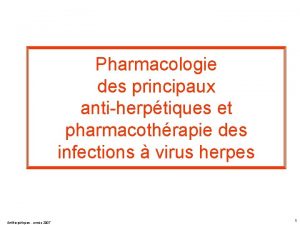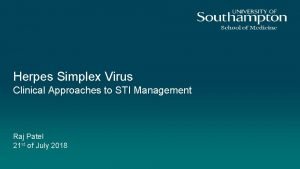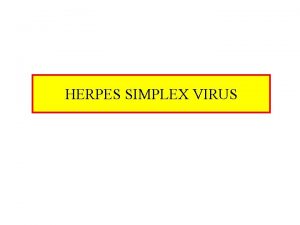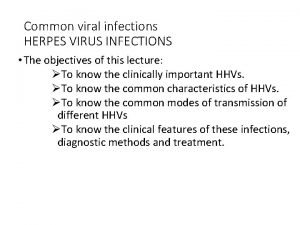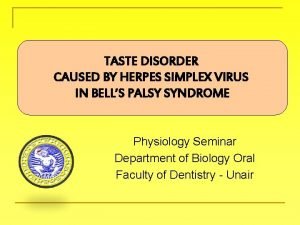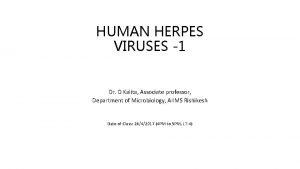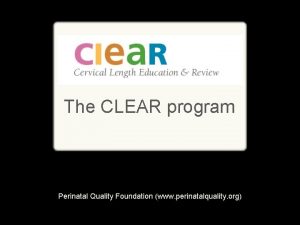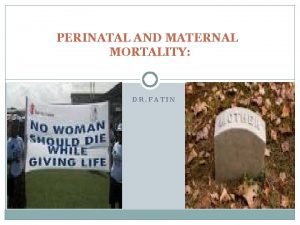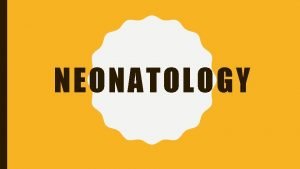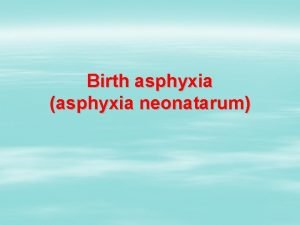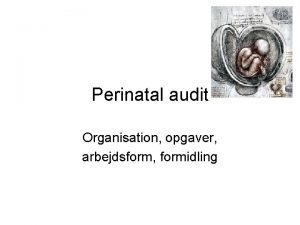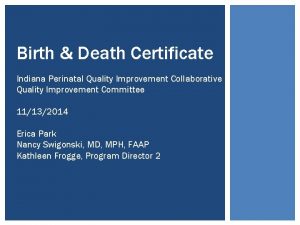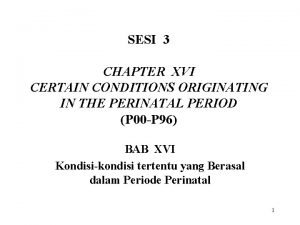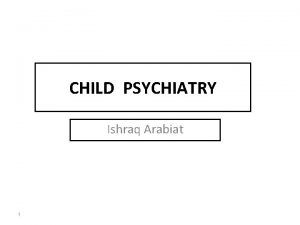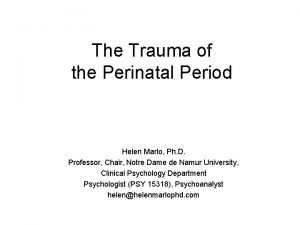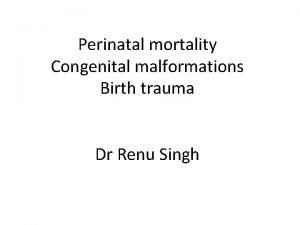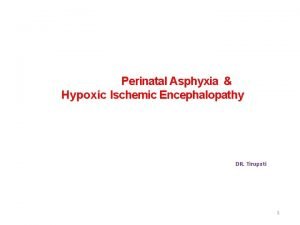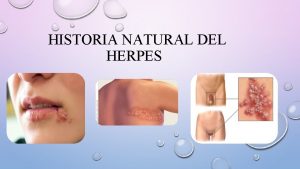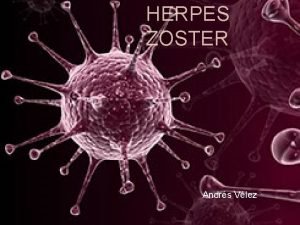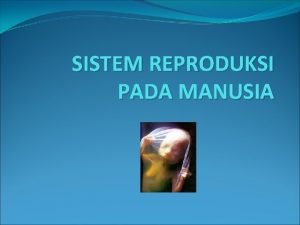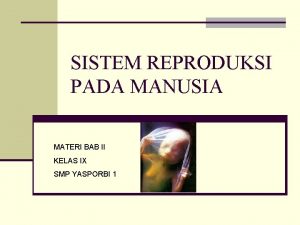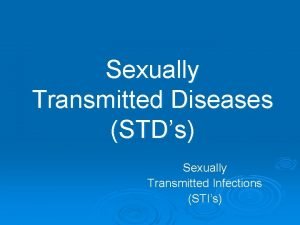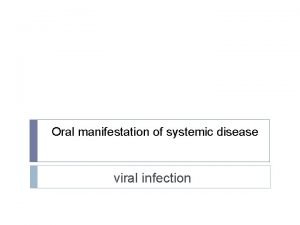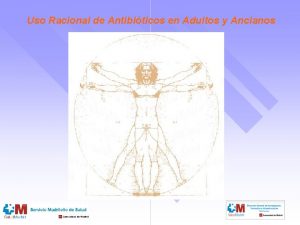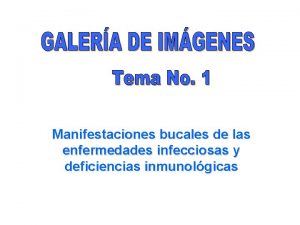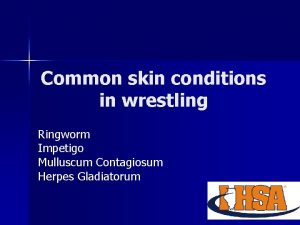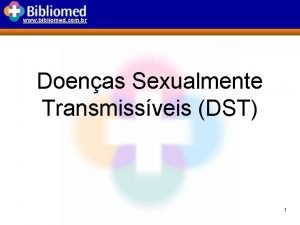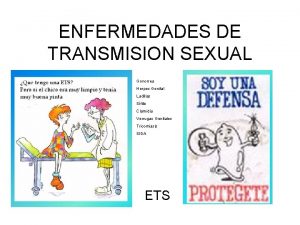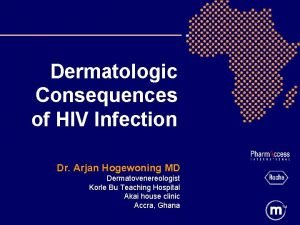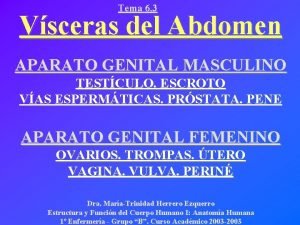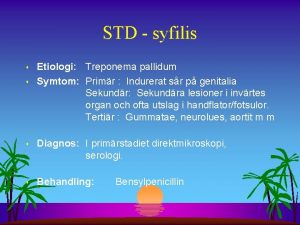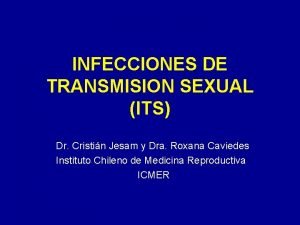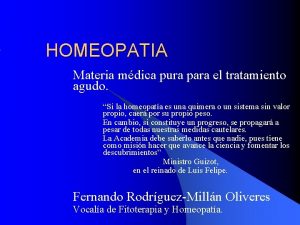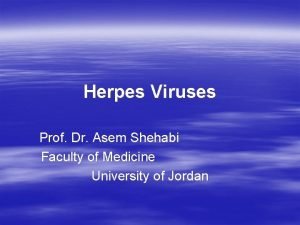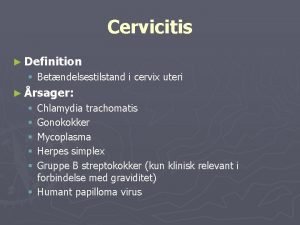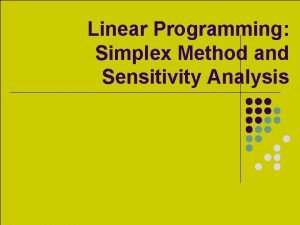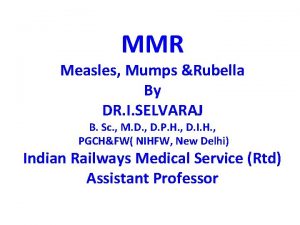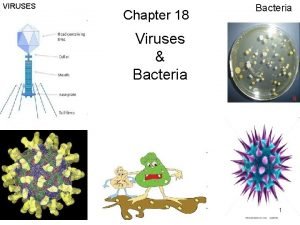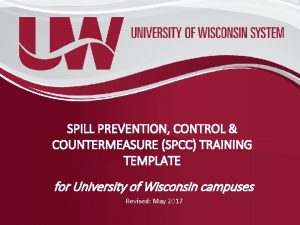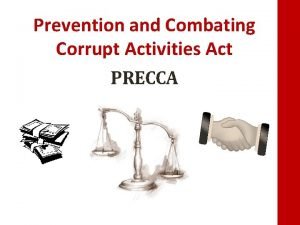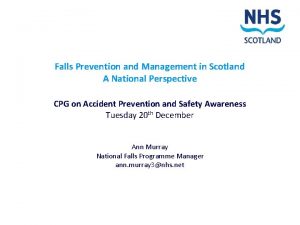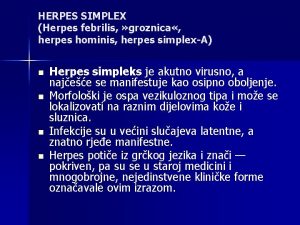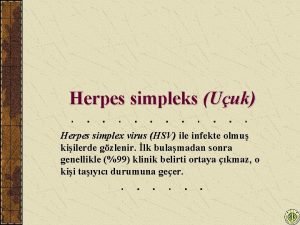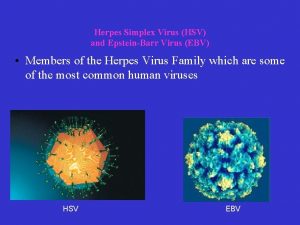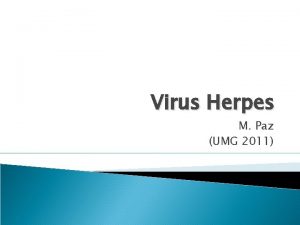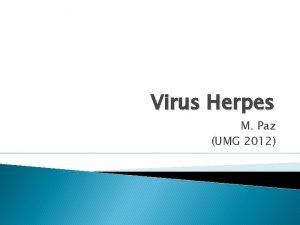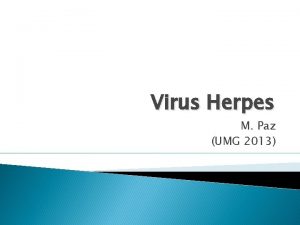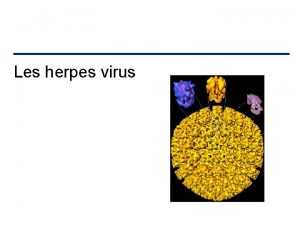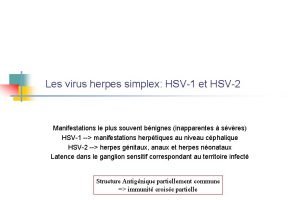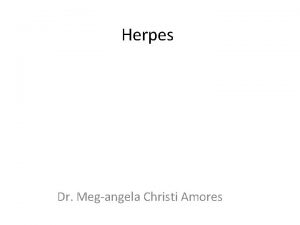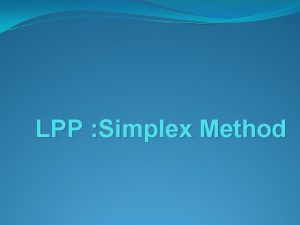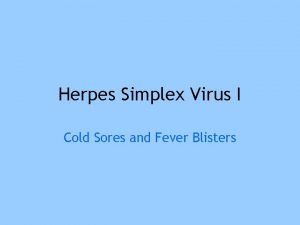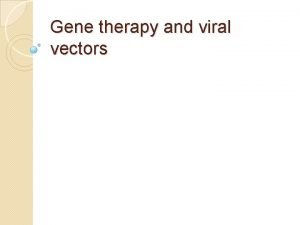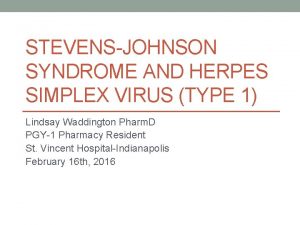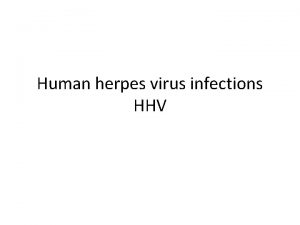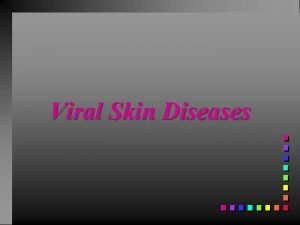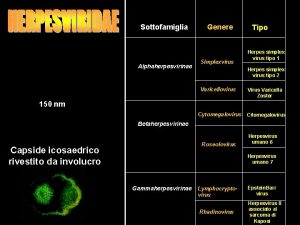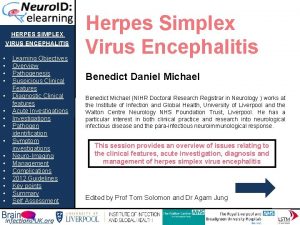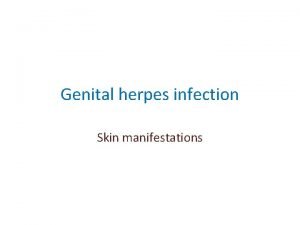Prevention and management of perinatal Herpes Simplex Virus


































































- Slides: 66

Prevention and management of perinatal Herpes Simplex Virus infections Idaho Perinatal Project Ann J. Melvin MD, MPH February 19, 2015

Disclosures �Nothing to disclose

Objectives �Understand the epidemiology and risks for perinatal transmission of HSV �Understand the management of HSVexposed infants �Understand the diagnosis and short and long-term management of neonatal HSV disease

5 day-old infant presented to the ED because her parents thought she was breathing fast. In the ED she had a temp of 100. 6, RR 52, O 2 sat 60%. A r/o sepsis work-up was initiated and she was started on ampicillin, gentamicin and acyclovir. AST- 5398, ALT-1363, plts 72 k

Admission

Next day

Bacterial cultures – negative HSV FA from the nasopharynx- positive HSV plasma PCR – 2, 600, 000 copies/ml HSV-2 Quickly progressed to high frequency ventilation. NICU stay complicated by E. coli sepsis requiring ECMO and CRRT. Ultimately discharged after an 8 week hospital stay.

Epidemiology of maternal HSV

points �HSV infection is common in adults �Most infections are asymptomatic �Most women who are infected don’t know they are �Women aged 15 -30 are most at risk of acquiring HSV

HSV seroprevalence adults. NHANES -1999 -2010 � 15. 7% HSV-2 seroprevalence 2005 -2010 �no significant change from 1999 -2004 � 54% HSV-1 seroprevalence 2005 -2010 � 7% from 1999 -2004 Bradley et al. JID 2014 NHANES n>11, 000

Figure 1. Herpes simplex virus type 1 seroprevalence by age and time period. JID Bradley et al 2014

Figure 2. Herpes simplex virus type 2 seroprevalence by age and time period. JID Bradley et al 2014

HSV seroprevalence in pregnancy �Chart survey >15, 000 delivering at the Univ Wash Med Center 1989 -2010 � 9% seropositive HSV-2 only � 15% seropositive HSV-1 and 2 � 53% seropositive HSV-1 only � 23% seronegative for both �Decrease in seroprevalence of HSV-2 by 4. 8%/yr Delaney et al. JAMA 2014; 312: 746

Rate of acquisition of HSV � 3438 women ages 18 -30 initially seronegative for HSV followed for 20 months (Control arm of the HERPEVAC trial) �HSV-1 acquisition � 127 (3. 7%)-2. 5 / 100 person-years � 74% asymptomatic �HSV-2 acquisition � 56 (1. 6%) – 1. 1 /100 person-years � 63% asymptomatic � 84% of recognized disease was genital Bernstein et al. CID 2013: 56: 344

Incidence of neonatal HSV disease �-. 5 – 3 / 10, 000 live births in U. S. �~23, 000 births/yr in Idaho – 1 -7/year �~80% of infants with neonatal HSV infection are born to women without a history or clinical evidence of HSV infection

Risk of maternal to infant HSV transmission

points �Women acquiring HSV late in pregnancy are most at risk for transmitting to their infants �Most infected infants are born to women with clinically inapparent infection at delivery �Decreasing infant exposure to the virus is protective

Risk of transmission �Type of maternal infection (genital culture positive at delivery) �Recurrent: 1 -3% � 1 st episode (non-primary): 25 -30% � 1 st episode (primary): 40 -45% Brown et al. N Engl J Med. 1991; 324(18): 1247 Brown et al. JAMA 2003, 289: 203

Risk factors for transmission �HSV shedding at delivery � 5% of infants infected if women were culture positive (OR 346) �Caesarean delivery � 1. 2% vs 7. 7% (OR 0. 14) �HSV-1 vs HSV-2 (OR 17) �Invasive monitoring (OR 7) �Prematurity �Maternal age < 21 years Brown et al. JAMA 2003, 289: 203

Prevention of perinatal HSV transmission

Prevention �No recommendation for HSV serologic testing during pregnancy �If couples are known to be discordant for HSV (pregnant woman positive and partner negative): �Condom use during first two trimesters �Abstinence during the third trimester- including oral-genital if partner is HSV-1 positive

Prevention �Acyclovir or valacyclovir �Starting at 36 weeks for women with recurrent disease during pregnancy � Reduces risk of recurrence at delivery by ~75% � Reduces rate of caesarean by ~40% � Reduces rate of HSV detection by PCR or culture at delivery by 90% �No study has been sufficiently powered to demonstrate reduction in infant infection Hollier LM, Wendel GD. Cochrane Database of Systematic Reviews 2008, Issue 1

Prevention �Acyclovir or valacyclovir �ACOG recommends offering suppressive acyclovir to women with a history of genital HSV starting at 36 weeks. �Not completely protective – cases of neonatal HSV when the mother was taking acyclovir prophylaxis have been reported Hollier LM, Wendel GD. Cochrane Database of Systematic Reviews 2008, Issue 1

Prevention of neonatal HSV �Cesarean section �Women with active lesions at time of delivery �Women with prodromal symptoms �Protection with C-section not complete: ~10% of infected infants born by C-section in a large case series �Avoidance of invasive perinatal procedures in women with known HSV �AROM, Fetal scalp monitoring, forceps, etc.

Diagnosis of genital HSV disease �Viral culture – sensitivity is lower for recurrent infections �PCR – more sensitive, but not always available �Serology – FDA approved type-specific antibody tests for HSV-1 and HSV-2 Ig. G are available

Management of the HSV-exposed infant

AAP guidance �Women in labor with visible genital lesions consistent with HSV should have the lesions swabbed for HSV culture and PCR. Positive tests should be typed. �Maternal antibody status should be determined Kimberlin D and the AAP Committee on Infectious Diseases. Guidance on Management of Asymptomatic Neonates Born to Women With Active Genital Herpes Lesions. Pediatrics 2013; 131: e 635.

AAP guidance �Asymptomatic infant born to a woman with lesions at delivery and a previous history of genital HSV �Swabs for HSV culture (+/- PCR) should be obtained from the nasopharynx, conjunctiva, mouth, rectum and site of fetal scalp electrode (if applicable) – about 24 hours after delivery �Obtain blood for HSV DNA PCR �If cultures are negative for 48 hours and PCR is negative, infant can be discharged with close follow-up

AAP guidance �Asymptomatic infant born to a woman with lesions at delivery and no previous history of genital HSV �Send maternal type-specific serology �Swabs for HSV culture (+/- PCR) should be obtained from the nasopharynx, conjunctiva, mouth, rectum and site of fetal scalp electrode (if applicable) – about 24 hours after delivery �Obtain blood for HSV DNA PCR �Get CSF cell count, chemistries and HSV PCR �Serum ALT �Start acyclovir 60 mg/kg/day div q 8 hours

AAP guidance �If maternal recurrent infection is documented �Viral isolate and maternal serology match �And PCRs and cultures are negative at 48 -72 hours �Discontinue the acyclovir, educate the family about signs and symptoms of HSV disease and monitor

AAP guidance �If mother is determined to have either primary disease or first-episode nonprimary disease �Viral isolate and maternal serology don’t match �And PCRs and cultures are negative at 48 -72 hours �And CSF parameters are normal and ALT (<2 x. ULN) �And infant remains asymptomatic �Treat with acyclovir pre-emptively for 10 days

AAP guidance �If mother is determined to have either primary disease or first-episode nonprimary disease �Viral isolate and maternal serology don’t match �Any of the infant testing is positive for HSV �Treat for neonatal HSV disease

Timing of Transmission � 5% in utero �If <20 weeks can result in spontaneous abortion, hydranencephaly, chorioretinitis, etc. � 85% intra-partum �Via conjunctiva, nasopharynx, skin or trauma (e. g. fetal scalp monitor) � 10% post-partum �Exposure to caregiver with herpetic whitlow, orolabial or breast lesions

Women with primary HSV gingivostomatitis during pregnancy �Case series from Seattle Children’s Hospital found 7 neonates whose mother’s had primary HSV-1 gingivostomatitis during pregnancy � 2 in first trimester and 5 in the third trimester � 3 infants with SEM, 2 with CNS disease and 2 with disseminated disease �One infant with disseminated disease died Healy et al. JPIDS 2012: 1: 1 -7.

Presentation of neonatal HSV

Clinical Manifestations �Skin, Eye, Mouth (SEM) disease (30 -40%) �No CNS or other organ involvement �Central Nervous System (CNS) disease (34%) �+/- SEM, but no other organ involvement �Disseminated disease (20 -30%) �Can include CNS Kimberlin et al. Pediatr 2001; 108: 223 Whitley et al. J Infect Dis 1988; 158: 109 -16

Neonatal HSV disease �Rarely asymptomatic � 68% with skin lesions at time of presentation � 39% with fever � 38% with lethargy � 27% with seizures � 19% with conjunctivitis � 13% pneumonia Kimberlin et al. Pediatr 2001; 108: 223

Age at onset of symptoms �Time of disease onset in affected infants �<24 hours – 9% � 1 -5 days – 30% �>5 days – 60% �Disease onset varies with type of disease �Disseminated disease (mean 11 days) �Skin, eye, mouth (means 11 days) �CNS disease (17 days) Kimberlin et al. Pediatr 2001; 108: 223

SCH experience (1993 -2012) � 63 infants �Age at diagnosis -days �Disseminated disease 7 (4 -15) �SEM 9 (2 -19) �CNS 17 (5 -34)

SEM Disease �Presents ~10 days of life �Well except vesicles and/or keratoconjunctivitis (can be subtle) � 75% presenting as SEM go on to CNS or disseminated disease if untreated �Outcome good if treated

Neonatal HSV Color atlas and synopsis of clinical dermatology Ed. Fitzpatrick et al. Pg 799

www. med. cmu. ac. th/. . . /ic-5 -neonatal-HSV/case. htm

CNS Disease �Later onset (3 rd week of life) – but can present early �Often present with seizure, lethargy, irritability, poor feeding, temperature instability �Neurologic sequelae �Cognitive impairment �Spastic quadriparesis �Microcephaly �Blindness � 30 -40% without skin lesions

Kubota et al. Brain & Develop 2007; 29: 171 -3.

Disseminated Disease �Onset 7 -10 days of age �Initial symptoms may be subtle �May present with CNS symptoms, lethargy, fever, respiratory distress, jaundice, DIC, shock �Lung, liver, adrenals and/or brain involvement �~40% without skin lesions

Diagnosis

Diagnosis �Early diagnosis and treatment greatly decrease morbidity and mortality �Must have high level of suspicion (17 -39% have no lesions, symptoms non-specific) � 60 -80% of women who transmit HSV to their neonate have no known history of genital infection �Those with a previous history, even with active recurrence, would be at LESS risk than 1 st episode without lesions

Work-up of infant with suspected HSV infection �CBC, LFTs, coag’s, BUN/creatinine �CXR if respiratory symptoms �Swabs of conjunctiva, oropharynx and lesions for viral FA and culture �Rectal swab for viral culture �Blood for HSV PCR �CSF cell count/chemistry and HSV culture and PCR

Who should get an HSV w/u? �Infant < 4 wks with lesions, seizures, hepatitis, DIC, pneumonia, conjunctivitis, CSF pleocytosis �Infant with symptoms of sepsis with bacterial Cx negative at 48 hours without improvement �Despite advances, mean duration of symptoms before diagnosis and treatment is still >5 days in the U. S.

Sensitivity of HSV DNA PCR and cultures- SCH cohort SEM n=26 14/18 (78%) CNS n=18 7/11 (64%) DIS n=19 18/18 (100%) CSF PCR positive, n (%) 2/24 (8%) 13/18 (72%) 9/14 (64%) Surface cultures positive, n (%) 24/25 (96%) 9/18 (50%) 45/61 (74%) Plasma PCR positive, n (%)

Treatment of neonatal HSV

Treatment �Start therapy empirically while awaiting tests �High dose (60 mg/kg/day IV Q 8 h) for 21 days or 14 days if limited to SEM �Decreased mortality from 61% with 10 mg/kg to 31% for disseminated disease � 19% to 6% for CNS disease Kimberlin Peds 2001108: 230

Treatment, cont’d �Ensure adequate hydration status �Monitor renal function and CBC, ANC �Confirm CSF normal, and negative by HSV PCR before discontinuation of therapy �For eye involvement, topical antiviral therapy in addition to IV and Ophtho consult � 1 -2%trifluridine � 0. 1% iododeoxyuridine, or � 3% vidarabine

Outcome

Predictors of Poor Outcome �Extent of infection: �disseminated> CNS> SEM �Disseminated disease: �Lethargy at presentation �AST > 10 x normal �CNS disease: �Seizures on presentation

Morbidity and Mortality After 12 Months of Age by Viral Type �Trend toward higher mortality with type 1 �Intact survival worse with type 2 Kimberlin et al. Pediatr 2001; 108: 223

SCH cohort � 63 infants �All but 2 treated with high-dose acyclovir �Outcome �SEM – 0% mortality 0% neurologic deficits �CNS – 0% mortality 65% neurologic deficits �DIS - 32% mortality 17% neurologic deficits

HSV plasma viral level and outcome

HSV CSF viral level and outcome

Plasma viral load decline on treatment HSV plasma PCR log 10 copies/ml 9 8 7 6 5 R 2 = 0. 9883 4 3 2 1 0 0 20 40 60 Age in days 80 100 120

Acyclovir suppression

Acyclovir for suppression of recurrences �Skin recurrences after primary infection are common ->50% �Frequent skin recurrences is associated with worse neurologic outcome �Oral acyclovir can prevent skin recurrences

Acyclovir for suppression of recurrences � 45 infants with CNS and 29 with SEM disease randomized to 6 months oral ACV vs placebo � 28 CNS and 15 SEM had Bayley ND exams at 12 months �CNS infants on acyclovir had higher Bayley scores at 12 months (p=0. 049) �Both groups had fewer cutaneous recurrences Kimberlin et al. NEJM 2011; 365: 1284 -92

Acyclovir suppression recommendations �Recommend – following treated CNS disease �Acyclovir dosing – 300 mg/m 2/dose q 8 hours �Monitor CBC monthly– neutropenia common �Consider following SEM disease �Advantages �Fewer medical evaluations for recurrent disease �Less difficulty with child care, etc

References

Questions?
 Herpes simplex virus
Herpes simplex virus Faringite
Faringite Herpes simplex virus
Herpes simplex virus Hsv encephalitis
Hsv encephalitis Primary prevention secondary prevention tertiary prevention
Primary prevention secondary prevention tertiary prevention Hsv
Hsv Stylomastoideus
Stylomastoideus Herpes virus classification
Herpes virus classification Clear perinatal quality
Clear perinatal quality Grof perinatal matrices
Grof perinatal matrices Fatin organ
Fatin organ Perinatal asphyxia
Perinatal asphyxia Perinatal asphyxia
Perinatal asphyxia Perinatal audit
Perinatal audit Motor gelişimi etkileyen faktörler
Motor gelişimi etkileyen faktörler Indiana perinatal quality improvement collaborative
Indiana perinatal quality improvement collaborative Certain conditions originating in the perinatal period
Certain conditions originating in the perinatal period Ccqi perinatal standards
Ccqi perinatal standards South dakota perinatal association
South dakota perinatal association Standing around crying
Standing around crying Perinatal period
Perinatal period Ruta materno perinatal
Ruta materno perinatal Waiter's tip deformity
Waiter's tip deformity Perinatal asphyxia
Perinatal asphyxia Herpes genitalis gravid
Herpes genitalis gravid Historia natural del herpes labial
Historia natural del herpes labial Herpes zoster clasificacion
Herpes zoster clasificacion Herpes simpleksserotipe 2
Herpes simpleksserotipe 2 Herpes simpleksserotipe 2
Herpes simpleksserotipe 2 Tempat untuk memproduksi ovum
Tempat untuk memproduksi ovum Corrimento líquido como água
Corrimento líquido como água Genial herpes
Genial herpes Herpes rugbiorum
Herpes rugbiorum Que es diagnostico diferencial
Que es diagnostico diferencial Goma sifilis
Goma sifilis Gingivostomatita herpetica
Gingivostomatita herpetica Varicella zoster complications
Varicella zoster complications Herpes zoster
Herpes zoster Mulluscum contagiosum
Mulluscum contagiosum Herpes genital tratamento definitivo
Herpes genital tratamento definitivo Herpes zoster
Herpes zoster Enfermedades de transmision sexualidad
Enfermedades de transmision sexualidad Herpes zoster infection
Herpes zoster infection Paraproctio
Paraproctio Syntom på klamydia
Syntom på klamydia Its
Its Ledum palustre posologia
Ledum palustre posologia Herpes latency
Herpes latency Rhinopneumonitis definition
Rhinopneumonitis definition Herpes genital glande
Herpes genital glande Chlamydia inkubationstid
Chlamydia inkubationstid Sialoreea
Sialoreea What is zj in simplex method
What is zj in simplex method Simplex words examples
Simplex words examples Simplex method sensitivity analysis
Simplex method sensitivity analysis Simplex complex and compound sentences
Simplex complex and compound sentences Mumps medicine
Mumps medicine Bacteria virus fungi and parasites
Bacteria virus fungi and parasites Structure of bacteria and virus
Structure of bacteria and virus Virus and related threats
Virus and related threats Spill prevention control and countermeasure plan template
Spill prevention control and countermeasure plan template Prevention and combating of corrupt activities act summary
Prevention and combating of corrupt activities act summary Colorado division of fire prevention and control jprs
Colorado division of fire prevention and control jprs Injury prevention safety and first aid
Injury prevention safety and first aid Sssc falls prevention
Sssc falls prevention Puncture resistant container
Puncture resistant container Chapter 26 infectious disease prevention and control
Chapter 26 infectious disease prevention and control
